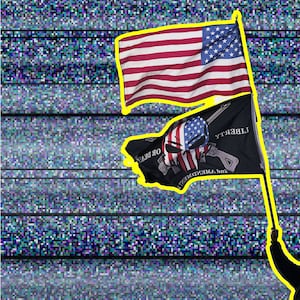While many Americans watched in horror as the racist Unite the Right rally in Charlottesville erupted into violence, some mourned their absence. “It’s like I didn’t get to go to the prom,” as David Pringle put it to me.
We stood in the Appalachian woods, outside the longtime headquarters of what was once America’s most dangerous neo-Nazi formation, the National Alliance, founded by the late William Luther Pierce, author of an infamous novel of racist futurism called The Turner Diaries. Pringle had big plans to restore the group to its former stature. That included being more visible at events like Charlottesville.
“A big conversation we had amongst ourselves here beforehand was, are we going to open carry?” Pringle said. “And if we were, what was our threshold going to be before we did something with it?”
It was fall of 2017 and I was in Pocahontas County, West Virginia, for what that would seem the antithesis of noxious white nationalism: I was researching the idea of quiet, and specifically how it manifests itself in the National Radio Quiet Zone, a 13,000-square-mile area where cell signals, WiFi, and other electronic noise are tightly monitored and restricted. I’d found that this quiet had attracted a number of groups over the decades, starting with astronomers who established the nation’s first federal radio astronomy observatory in the nearby town of Green Bank in 1956. At the beginning of my three-year quest to understand this place, it did not occur to me that a community based in quiet could be anything but idyllic. But I was soon finding more nefarious actors drawn by the quiet, too.
Leaders in the community had told me to not worry about the National Alliance—they’re harmless, they said, don’t focus on them. I could see their point in not wanting to give attention to a hate group. But I also felt I couldn’t ignore the flame of racism that had burned ever since Pierce acquired his 346-acre mountainside compound in 1984 and turned it into the base for his hate media empire, selling books, magazines, and “hatecore” music, all with some $1 million in annual sales. The analyst J. M. Berger of the International Centre for Counter-Terrorism at the Hague had recently warned that The Turner Diaries was likely to gain new traction amid a “highly charged social climate” in which “mainstream politicians ratify white racial fear and white nationalist beliefs predicated on worries about terrorism and immigration.” If Pierce had thrived in the Quiet Zone, what was to stop his organization from mounting a comeback?

To wit, Pringle said he was planning an alt-right festival for the coming April, on Hitler’s birthday. He was also recruiting new members by distributing outreach pamphlets around the country, which he called “cadre development.”
Pringle’s plans to attend Charlottesville had been derailed, however, by a four-wheeler accident in the nearby woods that broke his tibia-fibula. He’d been confined to a grimy old couch for weeks, forced to stream the Unite the Right rally over patchy internet. When an avowed neo-Nazi drove his car into a crowd of counterprotesters, killing a 32-year-old woman and injuring 28 others in what was deemed an act of domestic terrorism, Pringle had tweeted: “meep meep . . . lefties make great bowling pins! Look at the bounce on a couple of those fools! #2010DodgeChallanger #TakeTheDodgeChallange.” (He apparently forgot to spell-check “challange.”)
Other National Alliance members had attended the event, including a man named Albert “Jay” Hess, who had recently joined Pringle at the compound. As we spoke, Hess came outside, shirtless, wearing flip-flops and blue Corona-branded sweatpants.
“It was crazy,” Hess said of Charlottesville. “The police basically let everybody have at it.”
For the National Alliance, Charlottesville was successful in at least one regard: sales of The Turner Diaries spiked afterward. Pringle estimated a “couple hundred” sold in the following weeks, compared with the more normal dozen a month. He claimed new members had joined the organization and VICE News inquired about visiting the compound, though Pringle demurred. As the group’s former second-in-command, he would only allow photography and video once he had everything “extra, extra, extra tidy.”
The place looked as run-down as when I’d last visited, the forest reclaiming the land even as Pringle tried to convince me that he was making progress rehabbing the buildings and rebuilding community support. He’d recently recognized a man at the grocery store wearing a swastika belt buckle—Pringle referred to him as “the local Nazi diaspora.”
In addition to hosting monthly barbecues for such locals, Pringle said he was also keeping busy building a rifle, a “fun” project to try to replicate one of the longest-ever sniper kills, a distance of about 1.5 miles. A professional gunsmith, Pringle was recording footage of himself assembling the $14,000 rifle with music from a heavy metal band called Lamb of God.
“They’re total lefties but it’s got this great guitar,” he said, breaking into an air guitar solo.
Pringle made gun-building sound like a harmless hobby, though in the same breath he described his profession as “sharpening the Grim Reaper’s blade” and said he’d once given advice to a man named Jason McGhee on what kind of gun to purchase for the “specs” he was seeking—not that he knew McGhee would go on a murderous rampage with the weapon, he added. A former National Alliance employee, McGhee in 2006 shot and stabbed four people at a youth hangout in Georgia, killing them and injuring three more people. McGhee was one of three people charged in the attack and was sentenced to life in prison.
Pringle invited me inside to see his gun, retrieving it from a metal cabinet. A scope mounted to the barrel could aim to within an inch of accuracy from a mile away, he claimed. He handed it to me. Cold to the touch, the thing weighed at least twenty pounds. In the moment, I tried not to think about how unsettling the situation was: me with a neo-Nazi, handling his weapon, leaving my fingerprints everywhere before it was used for God knows what.
Since we were inside, Pringle offered to show me Pierce’s former study, leading me through a couple of doors. “We referred to it as the Sanctuary,” he said, pointing to where there once sat a giant leather-bound dictionary, a shelf of research books, and a large desk where the godfather of the modern white power movement had churned out vitriolic screeds. About two decades earlier, 60 Minutes correspondent Mike Wallace had interviewed Pierce in this same room. The Turner Diaries had sold almost two hundred thousand copies and become, according to Wallace, “the bible of Far Right militiamen like Timothy McVeigh, who is now awaiting trial for the Oklahoma City bombing.” Pierce credited McVeigh with attracting recruits to the National Alliance. Pringle, for his part, had said the murderer “should have a monument erected in his honor.”
We returned to the front of the building, where Pringle kept a small office. A bookshelf held copies of Pierce’s personal Bible, of Mein Kampf, and of My Awakening, by David Duke, the former Louisiana state congressman and KKK leader. There was a beer koozie with the words “David Duke U.S. Senate.” Duke was a friend, Pringle explained. He seemed to have a lot of infamous friends.
Another acquaintance was Dylann Roof, the young man awaiting execution for killing nine congregants at a historic Black church in South Carolina in 2015, including the pastor and a state senator. From prison, Roof wrote a letter to the National Alliance asking for reading material for a “political prisoner.” Roof said he’d already read The Turner Diaries, so Pringle mailed him back issues of National Vanguard and was now planning to send him a copy of The Lightning and the Sun, by Savitri Devi Mukherji, a French-born convert to Hinduism and Nazism who believed Hitler was an incarnation of the god Vishnu. Pringle was including a self-addressed stamped envelope so Roof could write back.
“I’m a nice guy, you know?” Pringle laughed. “And he’s a limited-time pen pal.”
Pringle handed me copies of The Turner Diaries and another Pierce novel, Hunter, about a racist serial killer who targets interracial couples and spurs copycat acts of violence. Pierce had dedicated Hunter to an American Nazi Party member named Joseph Paul Franklin who roved the country shooting Jews, Blacks, and people in interracial relationships. Franklin also attempted to murder the magazine publisher Larry Flynt for displaying interracial sex in Hustler, leaving him paralyzed. Franklin was executed after being convicted of eight murders between 1977 and 1980, but he claimed responsibility for at least a dozen more killings—including two in Pocahontas County, not far from the National Alliance compound.
Before I left, Pringle mentioned that he’d read my blog. A lump formed in my throat. I’d posted photos of hiking with my girlfriend, who is Korean. Was Pringle hinting that he knew I was in an interracial relationship?
In The Turner Diaries, on something called the Day of the Rope, thousands of people are hanged from lampposts, power poles, and tree limbs, each with a placard around the neck that says “I defiled my race” because they engaged in interracial relationships or were otherwise “traitors” to whiteness. I would be reminded of that scene in January 2021, when a violent mob erected a gallows outside the Capitol and called for legislators to get “the rope.” Analysts saw clear allusions to The Turner Diaries, and I would be unable to shake the idea that the roots of America’s racist right traced back to a mountainside hideaway in the Quiet Zone.
In Pierce’s nightmarish vision, people like my girlfriend and I would be strung up. In Franklin’s rampage of terror, he used a rifle to achieve the same end. It struck me that Pringle was assembling a gun that Franklin could only have dreamed of deploying. How many more might he have killed with the right weapon?
Adapted from the book THE QUIET ZONE: Unraveling the Mystery of a Town Suspended in Silence by Stephen Kurczy. Copyright © 2021 by Stephen Kurczy. From Dey Street Books, an imprint of HarperCollins Publishers. Reprinted by permission.


